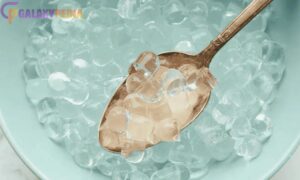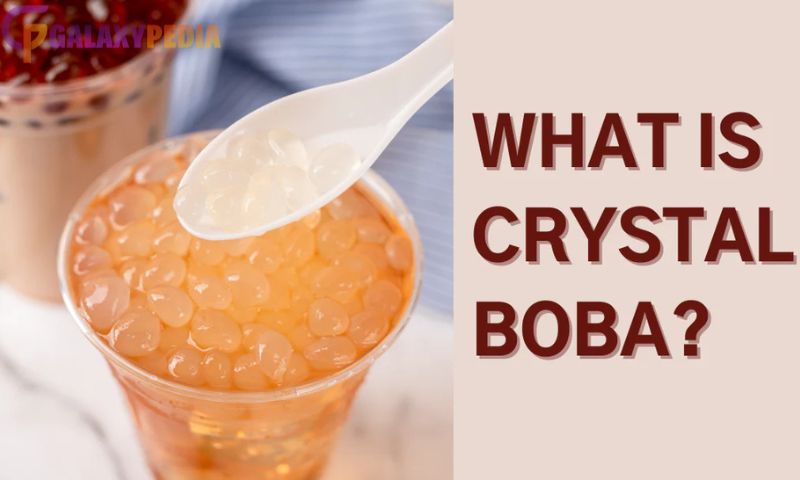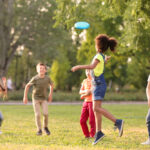Bubble tea has become one of the most popular beverages worldwide, offering a variety of toppings that make each drink unique. Among the many choices available, what is crystal boba has gained attention for its translucent appearance and chewy texture. But what is it, and how does it differ from traditional tapioca pearls? this is a unique type of bubble tea topping made from konjac, a plant-based ingredient known for its jelly-like consistency. Unlike regular boba, which is chewy and dark-colored, this is softer, slightly crunchy, and often comes in a light, transparent shade.
How is Crystal Boba Made?
This is primarily made from the konjac plant, which is a fibrous root vegetable commonly used in Asian cuisine. The konjac is processed into a jelly-like substance and then shaped into small, pearl-sized balls. These pearls are then soaked in flavored syrups to enhance their taste. Unlike traditional tapioca pearls, which require boiling, this is ready to eat right out of the package, making it a convenient option for bubble tea lovers.
Differences Between Crystal and Tapioca Pearls
When discussing what is crystal boba, it is essential to understand how it compares to the classic tapioca pearls. Traditional tapioca pearls are made from cassava starch and have a chewy, gummy texture. They are typically dark brown or black due to the caramel or brown sugar used in their preparation. On the other hand, this is much softer, has a more subtle crunch, and is often translucent or white. The flavor profile also differs, as it absorbs the syrup it is stored in, while tapioca pearls have a more neutral taste.
The Texture and Flavor of Crystal Boba
The texture of this is one of its defining features. Unlike the dense, chewy bite of traditional boba, this is much softer and slightly gelatinous. The flavor of crystal boba depends on the syrup it is soaked in. Some common flavors include honey, lychee, and citrus, making it a versatile addition to various bubble tea recipes. Its mild sweetness and subtle crunch make it a delightful topping that enhances the drinking experience.
Is Crystal Boba Healthier Than Regular Boba?
For those wondering what is crystal boba in terms of health benefits, it may be a better alternative to traditional tapioca pearls. Since it is made from konjac, it contains fewer calories and carbohydrates than tapioca-based boba. Konjac is also known for its dietary fiber content, which can aid digestion. However, the overall health benefits depend on the syrups used to flavor the boba, as high-sugar syrups can add extra calories.
Popular Ways to Enjoy Crystal Boba
this is not just limited to bubble tea. It can be used in various ways to enhance desserts and beverages. Some of the most popular ways to enjoy crystal boba include:
- Bubble Tea: The most common use, adding this to milk teas and fruit teas for a unique texture.
- Iced Beverages: Used in smoothies, iced coffees, and flavored lemonades for a refreshing twist.
- Desserts: Incorporated into yogurt, ice cream, and fruit salads for added texture and flavor.
- Cocktails and Mocktails: A fun addition to alcoholic and non-alcoholic drinks, giving them a unique, chewy element.
Where to Buy Crystal Boba
If you’re looking to try it at home, it can be found in various locations. Many Asian grocery stores carry ready-to-eat it in different flavors. It is also available online through specialty food retailers and major e-commerce platforms. Some bubble tea shops also sell pre-packaged crystal boba for customers who want to enjoy it at home.
How to Store Crystal Boba
Proper storage is essential to maintain the freshness of crystal boba. Since it does not require cooking, it is often stored in its original syrup in a sealed container. It should be kept in a cool, dry place and consumed within a few days of opening. If refrigerated, it can last for a longer period, but it may slightly change in texture over time.
How to Make Crystal Boba at Home

For those interested in making homemade crystal boba, the process is relatively simple. Here’s a basic method:
Gather Ingredients: You will need konjac powder, water, sugar, and your choice of flavoring (e.g., fruit juice or honey).
Prepare the Konjac Mixture: Dissolve the konjac powder in water and bring it to a low simmer while stirring continuously.
Shape the Boba: Once the mixture thickens, pour it into a mold or use a dropper to form small balls.
Cool and Set: Allow the pearls to cool and solidify before soaking them in flavored syrup.
Enjoy: Add your homemade this to tea, desserts, or any preferred dish.
Crystal Boba vs Popping Boba
Many people confuse crystal boba with popping boba, but they are quite different. Popping boba is made from a thin outer membrane filled with fruit juice that bursts upon biting. In contrast, it has a firm yet jelly-like texture and does not contain liquid inside. Both toppings offer unique textures, but this is preferred for those who enjoy a more subtle chew rather than an explosive burst of flavor.
Conclusion
Understanding what is this can help bubble tea lovers explore new flavors and textures. With its translucent appearance, mild sweetness, and soft yet crunchy bite, this is an exciting alternative to traditional tapioca pearls. It is also a lower-calorie option that can be enjoyed in various drinks and desserts. Whether you’re a bubble tea enthusiast or someone looking to try something new, this is definitely worth adding to your list of must-try toppings.
FAQs
1. What is crystal boba made of?
this is made from konjac, a plant-based ingredient known for its jelly-like texture.
2. How does crystal boba taste?
It has a mild sweetness and a slightly chewy yet soft texture.
3. Is crystal boba healthier than tapioca boba?
Yes, this generally has fewer calories and carbohydrates than traditional tapioca pearls.
4. Can you make crystal boba at home?
Yes, you can make it at home using konjac powder, water, sugar, and flavoring.
5. Where can I buy crystal boba?
This is available in Asian grocery stores and online through specialty food retailers.






